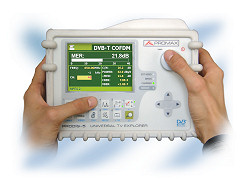Promax Support Section
Instruction Manuals
The best way to familiarize yourself with your new Promax analyzer and get started is to read the instruction manual. We keep a copy of the instruction manual for all Promax analyzers right here.
- Promax TV Explorer (Prodig 5A)
- Promax US TV Explorer (Prodig 5B)
- Promax TV Explorer II (Prodig 6A)
- Promax US TV Explorer II (Prodig 6B)
- Promax TV Explorer II+ (Prodig 7A)
- Promax HD Explorer (Prodig 9A)
- Promax US HD Explorer (coming soon)
- Prolink 4C Premium (P4CP)
- Prolink 4C Premium RS232 Commands
If you're too antsy to get started, you can also have a look at our online quick start guide.
Updating your Promax Analyzer
 To get the most out of the Promax 5, make sure it's up to date:
To get the most out of the Promax 5, make sure it's up to date:
You can update the firmware of your Promax 5 spectrum analyzer with these files:
For more information, you can also refer to the Promax support page.
Updating your satellite definitions
Once the firmware of your unit has been updated, you can also use PKUpdate to load the latest satellite definition:
PKTools
If you would like to create your own satellite definition tables and edit those currently in your Promax spectrum analyzer, PKTools is available on a CD ROM. A PKTools tutorial is available here.
You can also use PKTools ![]() to extract data logs and other information from your spectrum analyzer.
to extract data logs and other information from your spectrum analyzer.
You can purchase PKTools (latest version) here.
Recognizing Satellites
One of the question we get asked the most is "how do I know which satellite I'm on".
The best answer to this question is that once you get familiar with the spectral signature of the satellites you work with, you will be able to identify them, peak them and do cross-pol in spectrum mode without having to resort to the instrument's satellite recognition feature.
Regardless, we load our instruments with a list of North american frequencies on known Ku band satellites. If you have to setup a V-Sat system on G28/Ku/Vertical for example, you would use the preset 1410MHz Vertical frequency stored in the instrument under G28, because it features an Mpeg-2 DVB carrier that's excellent to confirm you're on the right satellite and perform cross-pol using the instrument's MER function.


